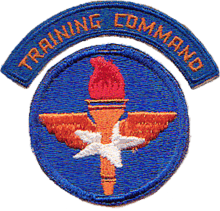32d Flying Training Wing (World War II)
| 32d Flying Training Wing | |
|---|---|
|
Locations of airfields controlled by the 32d Flying Training Wing | |
| Active | 1942-1946 |
| Country | United States |
| Branch | United States Army Air Forces |
| Type | Command and Control |
| Role | Training |
| Part of | Army Air Forces Training Command |
| Engagements |
|
The 32d Flying Training Wing is an inactive United States Air Force unit. It was last assigned to the Central Flying Training Command, and was disbanded on 13 October 1946 at the Randolph Field, Texas.
There is no lineage between the United States Air Force 32d Composite Wing, established on 22 November 1940 as the 32d Pursuit Group (Fighter) at Rio Hato Army Airbase, Panama, and this organization.
History
The wing was a World War II Command and Control organization which supported Training Command Basic Flight Schools. At the schools, Phase II Basic Pilot Training taught the cadets to fly in formation, fly by instruments or by aerial navigation, fly at night, and fly for long distances. Cadets got about 70 flight hours in trainers before being promoted to Advanced Training.[1]
Lineage
- Established as 32d Flying Training Wing on 17 December 1942.
- Activated on 16 January 1943
- Disbanded on 13 October 1946[2]
Assignments
- Army Air Forces Gulf Coast Training Center, 16 January 1943
- Re-designated: Central Flying Training Command, 31 July 1943-13 October 1946.[2]
Training aircraft
The primary aircraft used was the Vultee BT-13 Valiant twin-seat, single engine trainer. Mid-1930s era North American BT-9s were flown at Randolph until 1943. The North American BT-14 and the Vultee BT-15 were also used, the BT-15 being a higher-horsepower version of the BT-13.[1]
Beginning in late 1944 the USAAF (as well as the USN) began replacing the Vultee BT-13 / BT-15 Valiant from the Basic phase of flight training with the North American AT-6 Texan[1]
Assigned Pilot Schools
|
|
Stations
- Perrin Field, Texas, 16 January 1943
- Randolph Field, Texas
- Temporary assignment 31 Oct 1945, became permanent station on 5 August-13 October 1946[2]
See also
- Army Air Forces Training Command
- Other Training Command Basic Flight Training Wings:
- 27th Flying Training Wing (World War II) Eastern Flying Training Command
- 35th Flying Training Wing (World War II) Western Flying Training Command
- Other Central Flying Training Command Flight Training Wings:
- 31st Flying Training Wing (World War II) Primary Flight Training
- 33d Flying Training Wing (World War II) Advanced Flight Training
- 33d Flying Training Wing (World War II) Advanced Flight Training, Two Engine
- 34th Flying Training Wing (World War II) Bombardier and Specialized Two/Four-Engine Training
- 77th Flying Training Wing (World War II) Advanced Flight Training, Single Engine
- 80th Flying Training Wing (World War II) Navigation and Glider
References
![]() This article incorporates public domain material from the Air Force Historical Research Agency website http://www.afhra.af.mil/.
This article incorporates public domain material from the Air Force Historical Research Agency website http://www.afhra.af.mil/.
- 1 2 3 Manning, Thomas A. (2005), History of Air Education and Training Command, 1942–2002. Office of History and Research, Headquarters, AETC, Randolph AFB, Texas ASIN: B000NYX3PC
- 1 2 3 32d Flying Training Wing, lineage and history document Air Force Historical Agency, Maxwell AFB, Alabama
- ↑ www.accident-report.com: Curtis Field
- ↑ www.accident-report.com: Coffeyville Army Airfield
- ↑ www.accident-report.com: Enid Army Airfield
- ↑ www.accident-report.com: Garden City Army Airfield
- ↑ www.accident-report.com: Goodfellow Field
- 1 2 www.accident-report.com: Independence Army Airfield
- 1 2 3 4 5 Flight Training Field Fuselage Codes of World War II
- ↑ www.accident-report.com: Majors Army Airfield
- ↑ www.accident-report.com: Perrin Field
- ↑ www.accident-report.com: Randolph Field
- ↑ www.accident-report.com: Strother Army Airfield
- ↑ www.accident-report.com: Waco Army Airfield
_-_Map.png)
